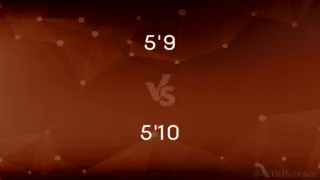Tensile Stress vs. Compressive Stress — What's the Difference?
Edited by Tayyaba Rehman — By Fiza Rafique — Published on December 1, 2023
Tensile Stress stretches a material; Compressive Stress compresses or shortens it.

Difference Between Tensile Stress and Compressive Stress
Table of Contents
ADVERTISEMENT
Key Differences
Tensile Stress refers to the internal forces that a material experiences when being pulled apart. It is a measure of how the material resists being stretched. Compressive Stress, on the other hand, describes the internal forces present when a material is pushed together or compressed. While Tensile Stress works to elongate a substance, Compressive Stress seeks to compact it.
Tensile Stress can be visualized when pulling on a rubber band. As force is applied to stretch the rubber band, it experiences tension. This force per unit area is the Tensile Stress. Compressive Stress, conversely, can be visualized when pressing down on a spring. The force pushing the spring's coils closer together results in Compressive Stress.
In structures like bridges, Tensile Stress is encountered in parts of the material that are being stretched under loads. Conversely, in columns or pillars bearing weight, Compressive Stress dominates as the load pushes down, trying to compact the material. In both scenarios, understanding Tensile Stress and Compressive Stress is vital to ensure structural integrity.
Materials have specific strengths related to Tensile Stress and Compressive Stress. Some materials, such as brittle ones, can withstand higher Compressive Stress but might fail under minimal Tensile Stress. Conversely, materials like rubber have high tensile strengths, meaning they can endure significant stretching before breaking.
Lastly, in the realm of engineering and material science, both Tensile Stress and Compressive Stress are critical. They dictate design choices, as materials must be chosen and arranged in ways that optimize their strengths and minimize their weaknesses concerning these stresses.
ADVERTISEMENT
Comparison Chart
Type of Force
Pulling or stretching
Pushing or compressing
Effect on Material
Elongates the material
Compacts or shortens the material
Common Examples
Stretching a rubber band
Pressing down on a spring
Material Response
Resistance to being stretched
Resistance to being compressed
Structural Relevance
Found in parts under tension (e.g., bridge cables)
Found in parts under compression (e.g., building columns)
Compare with Definitions
Tensile Stress
Tensile Stress acts perpendicular to the surface.
When fabric is pulled, the Tensile Stress acts across its cross-sectional area.
Compressive Stress
Compressive Stress results from pushing forces.
Bricks in a pillar handle Compressive Stress from the weight above.
Tensile Stress
Tensile Stress opposes elongation.
Rubber bands resist breaking due to their ability to handle Tensile Stress.
Compressive Stress
Compressive Stress is a measure of compression.
Stacked books exert Compressive Stress on the bottom one.
Tensile Stress
Tensile Stress is a measure of tension.
In a tug-of-war game, the rope faces Tensile Stress from opposing forces.
Compressive Stress
Compressive Stress opposes compression.
Columns resist buckling due to their ability to manage Compressive Stress.
Tensile Stress
Tensile Stress results from pulling forces.
When a rope is pulled taut, it undergoes Tensile Stress.
Compressive Stress
Compressive Stress acts inward on a material.
When clay is molded, it undergoes Compressive Stress from all sides.
Tensile Stress
Tensile Stress stretches materials.
Metal wires experience Tensile Stress when elongated.
Compressive Stress
Compressive Stress compacts materials.
Foam cushions experience Compressive Stress when sat upon.
Common Curiosities
What happens when Tensile Stress exceeds a material's limit?
The material can break or fail when Tensile Stress exceeds its tensile strength.
What is Tensile Stress?
Tensile Stress is the internal force in a material when it's being pulled apart.
Can a material experience both Tensile Stress and Compressive Stress?
Yes, depending on the forces applied, a material can experience both types of stresses.
How does rubber respond to Tensile Stress?
Rubber can stretch significantly, indicating a high tolerance for Tensile Stress.
Which is more common in columns: Tensile Stress or Compressive Stress?
Columns mainly experience Compressive Stress.
How does a spring respond to Compressive Stress?
A spring compresses or shortens under Compressive Stress.
How does Tensile Stress differ from tension?
While tension refers to the pulling force, Tensile Stress is that force's effect on a material's cross-sectional area.
Why is understanding Tensile Stress vital in bridge design?
Because parts of a bridge, like cables, experience Tensile Stress and must resist breaking.
How does Compressive Stress act on a material?
Compressive Stress pushes or compresses a material together.
Which stress, Tensile or Compressive, is dominant in an arch?
Arches primarily handle Compressive Stress due to their curved design.
What materials handle Compressive Stress well?
Brittle materials, like concrete, often withstand Compressive Stress better than Tensile Stress.
How can one increase a material's Compressive Stress resistance?
Reinforcing materials or changing their geometry can enhance Compressive Stress resistance.
Is Compressive Stress always negative?
Conventionally, Compressive Stress is considered negative, denoting compression.
Can materials be designed to optimize Tensile Stress and Compressive Stress handling?
Yes, engineering and material science aim to optimize materials' responses to both stresses.
What unit measures Tensile Stress?
Tensile Stress is typically measured in Pascals (Pa) or pounds per square inch (psi).
Share Your Discovery

Previous Comparison
5’9 vs. 5’10
Next Comparison
Action Verbs vs. Linking VerbsAuthor Spotlight
Written by
Fiza RafiqueFiza Rafique is a skilled content writer at AskDifference.com, where she meticulously refines and enhances written pieces. Drawing from her vast editorial expertise, Fiza ensures clarity, accuracy, and precision in every article. Passionate about language, she continually seeks to elevate the quality of content for readers worldwide.
Edited by
Tayyaba RehmanTayyaba Rehman is a distinguished writer, currently serving as a primary contributor to askdifference.com. As a researcher in semantics and etymology, Tayyaba's passion for the complexity of languages and their distinctions has found a perfect home on the platform. Tayyaba delves into the intricacies of language, distinguishing between commonly confused words and phrases, thereby providing clarity for readers worldwide.













































